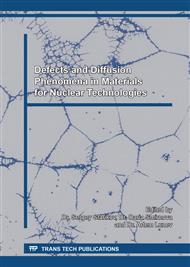[1]
M.S. Veshchunov, V.D. Ozrin, V.E. Shestak, et al, Development of mechanistic code MFPR for modelling fission product release from irradiated UO2 fuel, Nucl. Eng. Design 236 (2006) 179.
DOI: 10.1016/j.nucengdes.2005.08.006
Google Scholar
[2]
M.S. Veshchunov, R. Dubourg, V.D. Ozrin, et al., Mechanistic modelling of urania fuel evolution and fission product migration during irradiation and heating, J. Nucl. Mater. 362 (2007) 327.
DOI: 10.1016/j.jnucmat.2007.01.081
Google Scholar
[3]
A.V. Boldyrev, S. Yu. Chernov, A.P. Dolgodvorov et al., BERKUT – Best Estimate Code for Modelling of Fast Reactor Fuel Rod Behaviour under Normal and Accidental Conditions, Proc. Int. Conf. on Fast Reactors and Related Fuel Cycles (FR17), Paper IAEA-CN-245-363, Ekaterinburg, (2017).
Google Scholar
[4]
M.S. Veshchunov, A.V. Boldyrev, A.V. Kuznetsov, et al., Development of the advanced mechanistic fuel performance and safety code using the multi-scale approach, Nucl. Eng. Design 295 (2015) 116.
DOI: 10.1016/j.nucengdes.2015.09.035
Google Scholar
[5]
J.A. Turnbull, et al., The diffusion coefficients of gaseous and volatile species during the irradiation of uranium dioxide, J. Nucl. Mater. 107 (1982) 168–184.
DOI: 10.1016/0022-3115(82)90419-6
Google Scholar
[6]
A. Höh, Hj. Matzke, Fission-enhanced self-diffusion of uranium in UO2 and UC, J. Nucl. Mater. 48 (1973) 157–164.
DOI: 10.1016/0022-3115(73)90150-5
Google Scholar
[7]
G. Martin, S. Maillard, L. Van Brutzel, P. Garcia, B. Dorado, C. Valot, A molecular dynamics study of radiation induced diffusion in uranium dioxide, J. Nucl. Mater. 385 (2009) 351–357.
DOI: 10.1016/j.jnucmat.2008.12.010
Google Scholar
[8]
J.L. Wormald, A.I. Hawari, Examination of the impact of electron–phonon coupling on fission enhanced diffusion in uranium dioxide using classical molecular dynamics, J. Mater. Res. 30 (2015) 1485–1494.
DOI: 10.1557/jmr.2014.405
Google Scholar
[9]
M.W.D. Cooper, C.R. Stanek, J.A. Turnbull, B.P. Uberuaga, D.A. Andersson, Simulation of radiation driven fission gas diffusion in UO2, ThO2 and PuO2 ,J. Nucl. Mater. 481 (2016) 125–133.
DOI: 10.1016/j.jnucmat.2016.09.013
Google Scholar
[10]
C. Wise, Recoil release of fission products from nuclear fuel, J. Nucl. Mater. 136 (1985) 30.
Google Scholar
[11]
D.R. Olander, Fundamental Aspects of Nuclear Reactor Fuel Elements, TID-26711-Pl (1976), p.289–299.
Google Scholar
[12]
B.J. Lewis, Fission product release from nuclear fuel by recoil and knockout, J. Nucl. Mater. 148 (1987) 28–42.
DOI: 10.1016/0022-3115(87)90515-0
Google Scholar
[13]
G. H. Kinchin and R. S. Pease, The displacement of atoms in solids by radiation, Progr. Phys. 18 (1955) 1.
Google Scholar
[14]
G. Nilsson, Ejection of uranium atoms from sintered UO2 by fission fragments in different gases and at different gas pressures, J. Nucl. Mater. 20 (1966) 215.
DOI: 10.1016/0022-3115(66)90010-9
Google Scholar
[15]
J.F. Ziegler, SRIM – The stopping and range of ions in matter (2010), Nucl. Instrum. Methods Phys. Res. B 268 (2010) 1818–1823.
Google Scholar
[16]
M.D. Rogers, Ejection of uranium atoms from sintered UO2 , J. Nucl. Mater. 22 (1967) 103.
Google Scholar
[17]
S. Plimpton, Fast parallel algorithms for short-range molecular dynamics, J. Comp. Phys. 117 (1995) 1–19.
Google Scholar
[18]
A.Y. Kuksin, S.V. Starikov, D.E. Smirnova, V.I. Tseplyaev, The diffusion of point defects in uranium mononitride: Combination of DFT and atomistic simulation with novel potential, J. Alloy. Comp. 658 (2016) 385–394.
DOI: 10.1016/j.jallcom.2015.10.223
Google Scholar
[19]
E. Yakub, C. Ronchi, D. Staicu, Molecular dynamics simulation of premelting and melting phase transitions in stoichiometric uranium dioxide, J. Chem. Phys. 127 (2007) 094508.
DOI: 10.1063/1.2764484
Google Scholar
[20]
J.F. Ziegler, J.P. Biersack, U. Littmark, The stopping and range of ions in solids, Pergamon, New York, (1985).
Google Scholar
[21]
S.I. Potashnikov, A.S. Boyarchenkov, K.A. Nekrasov, A. Ya. Kupryazhkin, High-precision molecular dynamics simulation of UO2–PuO2: Pair potentials comparison in UO2, J. Nucl. Mater. 419 (2011) 217–225.
DOI: 10.1016/j.jnucmat.2011.08.033
Google Scholar


